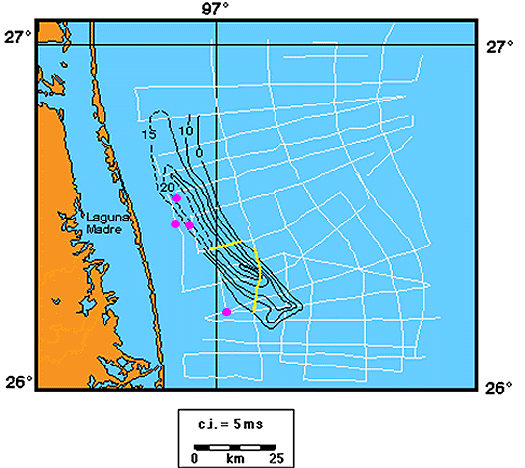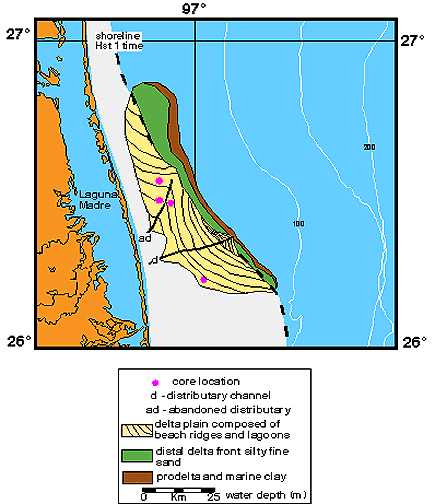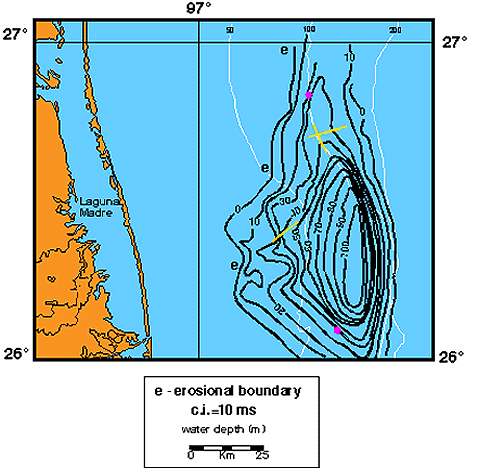South Texas
Highstand Systems Tract
In the Rio Grande study area, it is difficult to identify progradational reflection configurations in highstand deposits because topset beds are eroded by the Stage 2 sequence boundary. Due to uncertainty about their original geometry, distribution and thickness, an isochron of these reflectors is not included. Isochrons that show a preserved, inner shelf unit (Hst 1) and the outer shelf remnant of the youngest highstand deposit (Hst 2) are described.
HST 1
Hst 1 is an inner shelf deposit in approximately 20 to 45 m of modern water depth that trends roughly north-west to south-east. The unit has an elongate lens geometry.

width: 75 km (strike direction)
length: 15 km (dip direction)
thickness: 30 ms (22.5 m)
Hst 1 underlies a sixth-order maximum flooding surface associated with the Stage 5c highstand in sea level. The unit is separated from the amalgamated 5e maximum flooding surface and 5d surface by a zone of parallel to subparallel reflectors. Line 33b provides a dip perspective while line line 16/116 provides an oblique view of Hst 1. Both seismic lines display a progradational reflection configuration to the west and south grading into a more shingled and chaotic reflection configuration in the east and north.
Four lithologic descriptions and a generalized core transect with bounding surfaces and units exist for Hst 1.
The prograding seismic reflection configuration within Hst 1 is interpreted as a delta. The elongate lens geometry and the steep seaward margin of the unit combined with the lithologic descriptions suggest that it is a wave-dominated delta.

HST 2
Hst 2 is the youngest preserved Hst deposit. Landward of the unit, the Stage 2 sequence boundary has removed all the deposits associated with Hst 2. Hst 2 trends roughly north to south and has a lobate, fan-mound geometry.

width: 95 km (strike direction)
length: 60 km (dip direction)
thickness: 100 ms (75 m)
Line 15 is a dip line from the middle shelf that shows the truncation of the prograding reflectors of Hst 2 by the overlying Stage 2 sequence boundary. Line 11a is a dip line from the outer shelf that demonstrates the complex sigmoid oblique reflection configuration of Hst 2. The unit overlies a fifth-order maximum flooding event associated with the Stage 3 highstand and underlies the Stage 2 sequence boundary. Seismic line 18 is a strike line from the outer shelf that demonstrates the parallel to subparallel reflection configuration of Hst 2 perpendicular to depositional dip.
Two lithologic descriptions and a generalized core transect with bounding surfaces and units exist for Hst 1.
Hst 2 is interpreted as a deltaic unit based on the prograding clinoform reflection configuration. The combination of the lobate fan-mouthed geometry, the complex-sigmoid-oblique to oblique tangential seismic pattern, and the lithologic information from the Rio Grande area and age equivalent deposits associated with the Colorado system suggests that it is a fluvially-dominated delta.

Comments, questions? Contact us at
gulf@gulf.rice.edu.




